The Experiences |
Experience The Experience Of Catapulting Wireless Devices
|
The term catapult (from the Greek kata + paltes, to hurl down or against) generally refers to a machine that converts conserved energy into movement (movement energy) with the aim of putting an object at rest into a state of motion (to 'catapult'). In antiquity and during the Middle Ages, the catapult was used to hurl stones or arrows. These devices were primarily implemented during sieges. The propulsion medium for this sort of catapult was usually a material such as wood, rope or sinew under tension, with the tension having been accumulated through the work of the operating personnel (bow and arrow principle).
The catapult is one of the oldest machines in the history of technology. It is no coincidence that monochrom would like to instigate a creative return. The knife edge of technology hype is sharp, most of all on the west coast of the United States. Thus monochrom would like to initiate a competition. We invite interested persons to design and build a catapult capable of hurling a cell phone or a PDA unit the greatest possible distance. In order to ensure that no participant has any unfair advantage, monochrom will provide a specifications list regarding materials (e.g. metal) that may not be used and other limitations (e.g. size and weight). San Francisco (RxGallery): Workshop: July 9, 6 PM. Event: July 16, 2 PM. |
What now?
July 22. Morning.
We're all flying back to Austria tomorrow... and we can't take our catapult with us.
So, what can we do?
We brainstorm...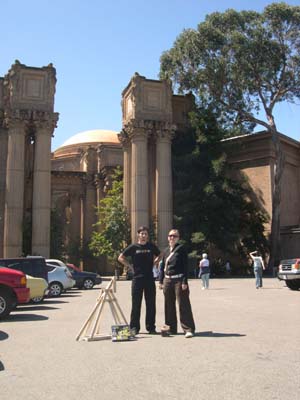
...and we have a cunning plan.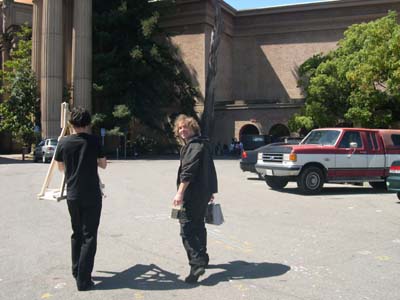
Why not donate it to the Exploratorium?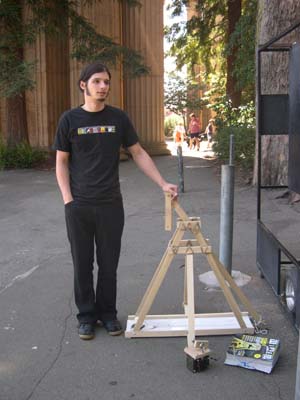
"Excuse me, I'm part of a group called monochrom. We have a present for you folks here."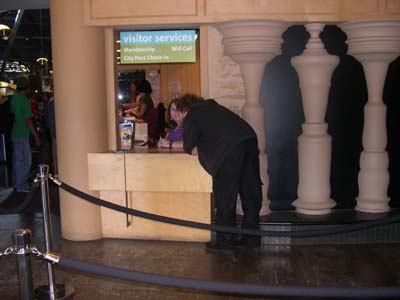
We get an all-day free membership! We can't hide our emotions!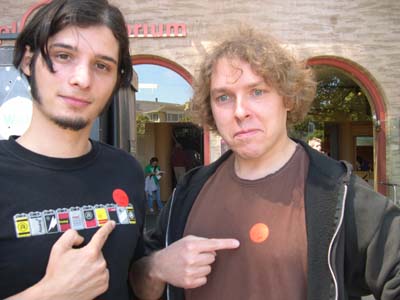
And we may enter the administrational office!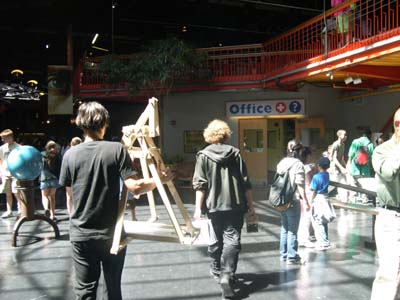
Tory, a nice member of the staff, accepts our present with thanks. The Exploratorium team now owns a trebuchet, a 12-issues-of-WIRED counterweight and an old school industry transformer counterweight.
Tory takes down our contact info... just in case the Exploratorium team needs some help.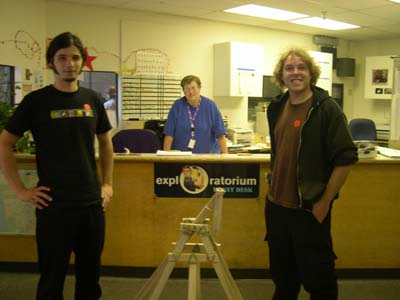
We're glad our beloved catapult found a new home.
We already miss you!
Good-bye!
[posted by johannes at
3:49 AM]
Carrying Out An Experience / Addendum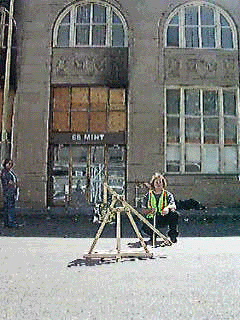
[posted by johannes at
3:33 AM]
Carrying Out An Experience
July 16. Afternoon.
2 PM:
Our guests arrive, and they bring cell phones.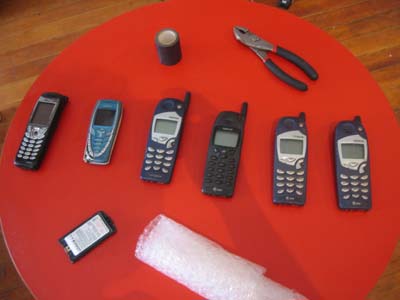
Daniel starts the routine of the day with a short introduction talk about the history of the catapult.
The first catapults were tensional catapults, developed from the Roman ballista.
Subsequently, torsional catapults were developed, such as the mangonel.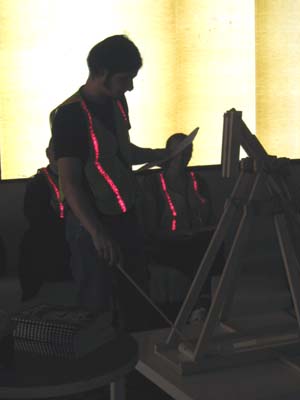
The last type of catapult is a trebuchet, which uses gravity rather than tension or torsion to propel the throwing arm.
Daniel explains the mechanism of our construction, ...a trebuchet.
A falling counterweight (12 issues of WIRED) pulls down the bottom end of the arm and the projectile is thrown from a bucket attached to a rope hanging from the top end of the arm.
Catapults were usually assembled at the site of a siege, and an army carried few or no pieces of it with them because wood was easily available on site.
We had to drive to Home Depot to get the material.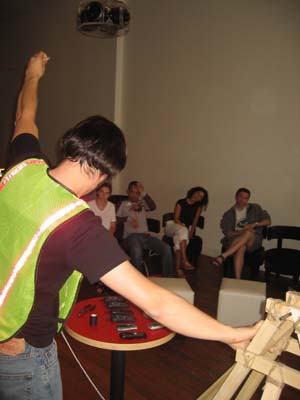
The catapult is one of the oldest machines in the history of technology. It is no coincidence that monochrom wanted to instigate a creative return. The knife edge of technology hype is sharp, most of all on the west coast of the United States.
Thus monochrom initiated a competition. We invited interested persons to design and build a catapult capable of hurling a cell phone or a PDA unit the greatest possible distance.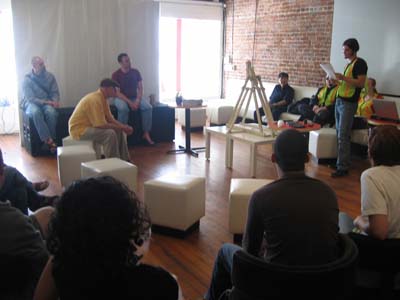
A couple of people attended our catapult design workshop on July 9.
We are curious.
Will a second or third team bring their own DIY catapult?
We wait until 2:45 PM.
No one shows up.
We win.
And it's time.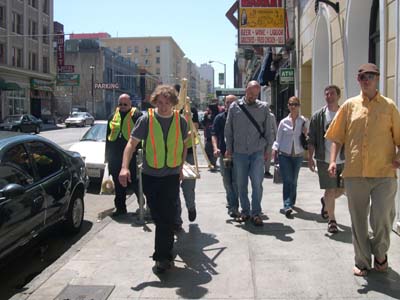
The chance of being arrested for catapulting wireless devices in a park full of innocent consumers is quite high. We choose a backstreet.
Decision: Mint Street is our launching site.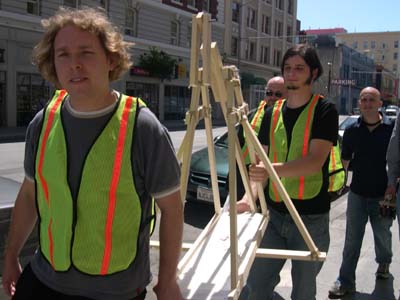
We check the surroundings...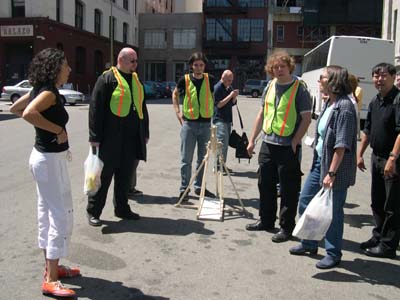
...and adjust our trebuchet.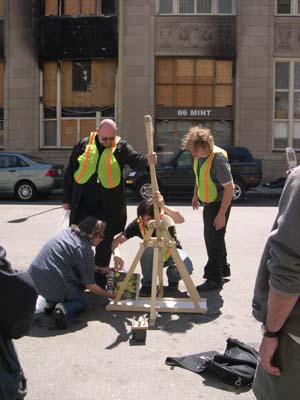
We mount the counterweight.
Will it be heavy enough?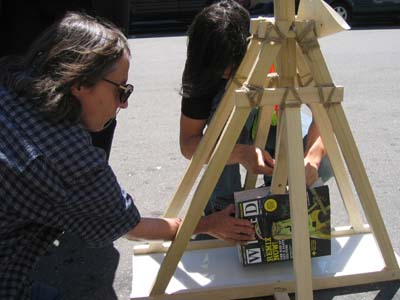
Will the force of techno-utopianism prevail?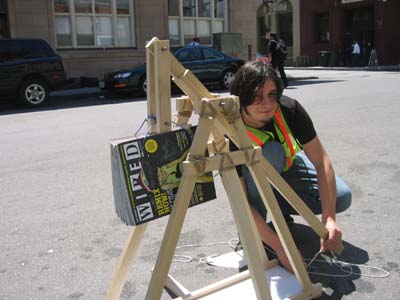
Anika, head of monochrom's security services, blocks the street.
(PS: There is no danger for the San Francisco Chronicle building.)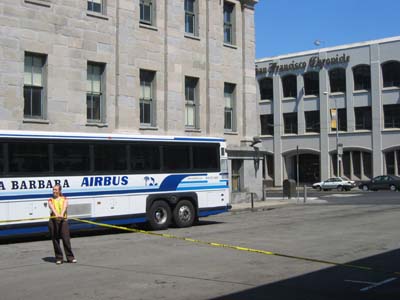
The science that deals with the motion and behavior of projectiles is called ballistics. It is the art of designing and hurling projectiles so as to achieve a desired performance.
"Fire!"
(Just a metaphor, no real fire around.)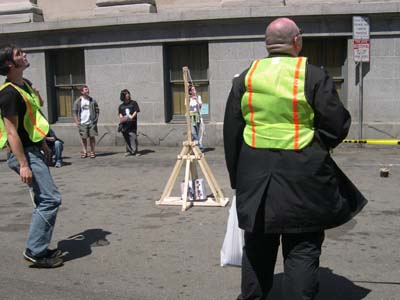
The phone flies as calculated...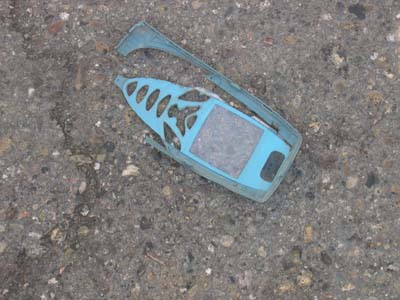
...and bursts on the hard street surface.
Viva ballistics!
We celebrate a gravitational victory.
But Günther reminds us: "Come on! No dilly-dally!"
And he is right. We have to accomplish quite a few shootings.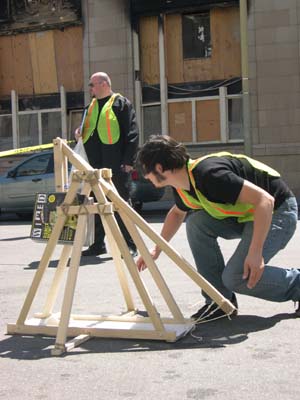
Daniel, chief designer and director of monochrom's internal quality assurance unit, re-calibrates the catapult.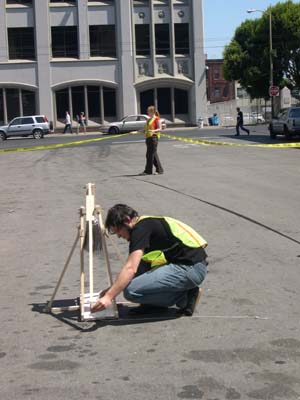
"3, 2, 1, go!"
(Zoom 0.)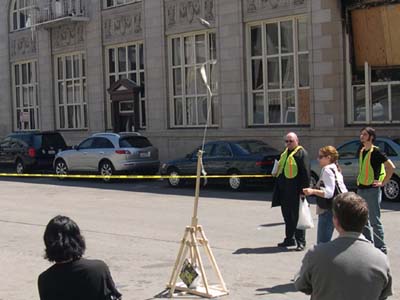
"3, 2, 1, go!"
(Zoom +3.)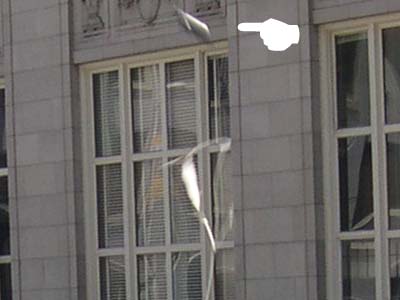
After fifteen successful launches, Daniel decides to replace the WIRED counterweight with the backup counterweight, an old school industry transformer.
What will happen?
Will the New Economy slide into a crisis?
"Go!"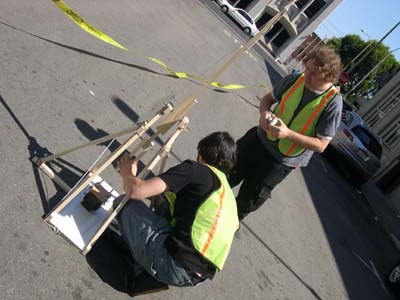
Oh no!
Dot-com crash!
The mighty power of pre-fordistic industry triumphs over the new markets!
The distance dramatically increases!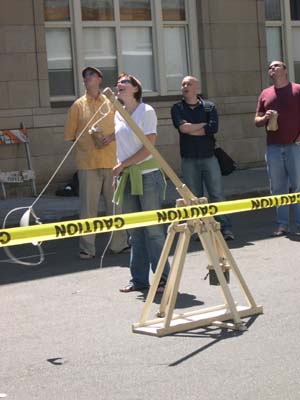
A survey among the spectators shows us that the public wants to use the old school counterweight.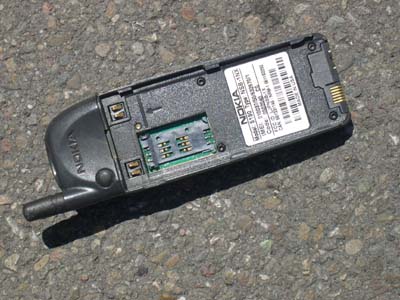
A) High efficiency!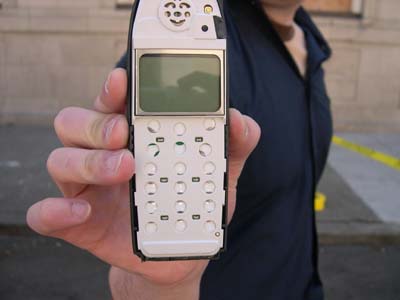
B) Incredible altitudes!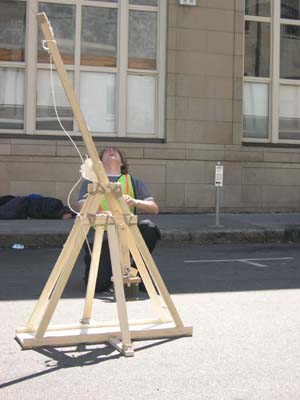
C) No growth over profits!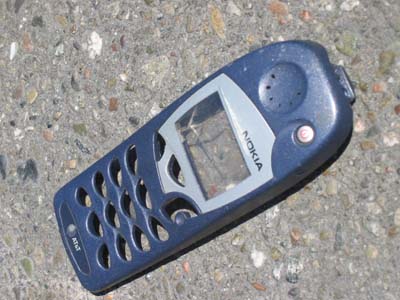
Jane, one of our guests, can't hide her emotion. She says good-bye to her beloved phone...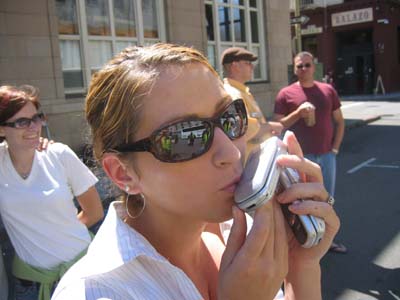
...and pulls the trigger...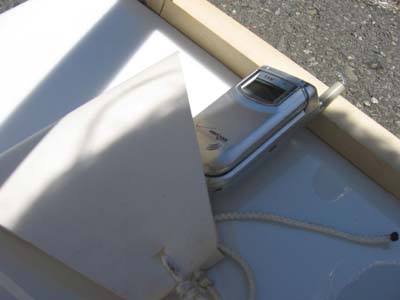
Quote: "Alas, my phone did not survive the trip, which consisted of a rather dramatic arc 30 feet in the air and a fatal crash landing 60 feet down the pavement. The damage inflicted: a smashed LCD screen with leaking crystal, a detached battery, a broken hinge, and exposed innards. If I don't return your calls for a few days, you know why."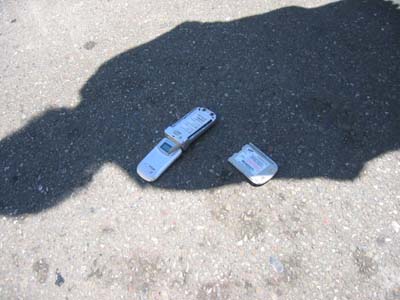
Not without respect, Daniel presents the only wireless device that was hurled four times: "And it is still intact. Not even the battery broke off."
The donor of the cell phone -- Monika Bernstein of RxGallery -- comments: "Actually, it's not my phone. Someone forgot it at gallery some time ago. Please blog the picture. Maybe the person is still looking for it. It's a good piece of equipment."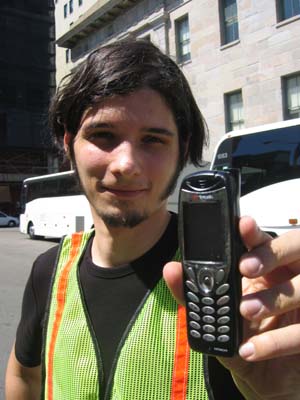
In accordance with the rules, Anika issues the certificates.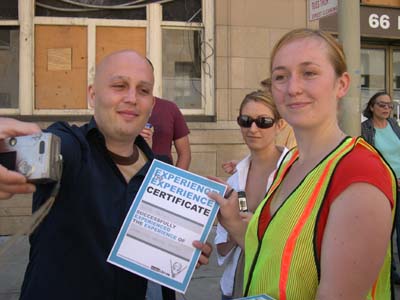
The certificates officially confirm that the attenders 'Experienced The Exprience Of Catapulting Wireless Devices'.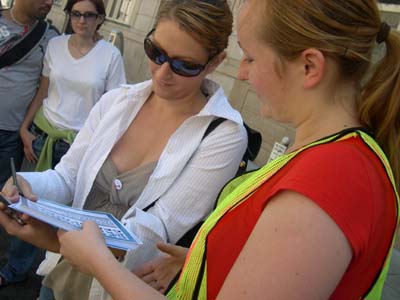
In less than twenty years, mobile telephones have gone from being rare and expensive pieces of equipment used by businesses to a pervasive low-cost personal item. In many affluent countries, mobile phones now outnumber land-line telephones.
Mobile phones are packed with features that offer users far more than just the capability to text message and make voice calls.
The world's largest mobile phone manufacturers are Alcatel, Audiovox, Kyocera, LG, Motorola, Nokia, Panasonic, Philips, Samsung, Sagem, Sanyo, Siemens, SK Teletech, and Sony Ericsson.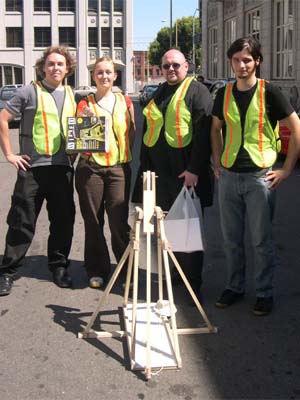
The team feels revolutionary optimism.
All has not been said and done.
[posted by johannes at
8:13 PM]
Final Test
July 16. Midday.
Daniel and Johannes take the catapult to ACE/McKinnon Street...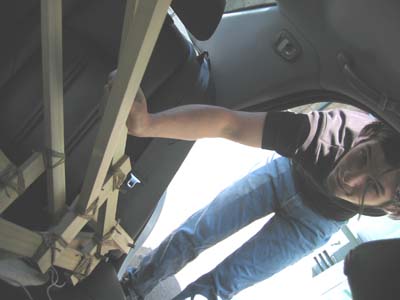
... to meet Bill (the Junkman).
He presents us with a beautiful variety of test ammunition.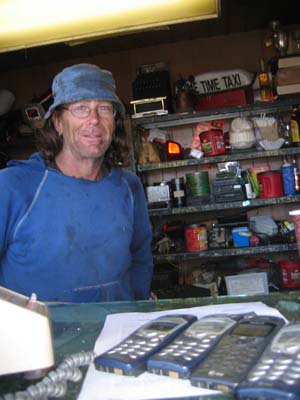
We have to deal with bugs in the release system (the catapult shoots backwards) -- but basically our construction works.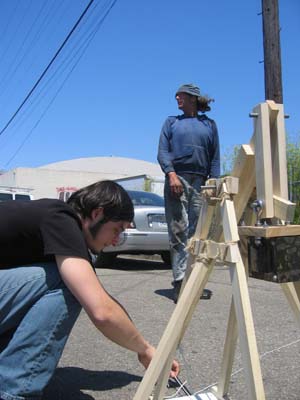
Time to get back to RxGallery.
[posted by johannes at
8:05 PM]
Sling and Counterweight / Final Preparations
July 15. Afternoon.
Our construction is moved by the weight of 12 issues of WIRED, a full-color monthly magazine published in San Francisco, California since March 1993. The axle of the arm is near the top of a high strutted vertical frame. The shorter arm of the balance carries the counterweight and the longer arm the sling that carries the shot.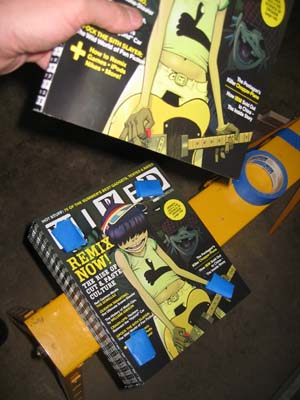
Johannes uses sticky tape to create a block of glossy paper.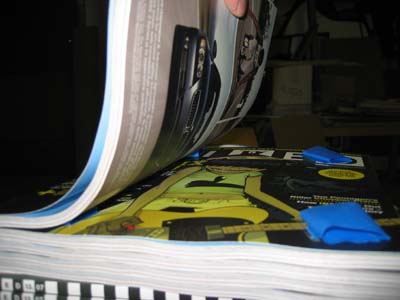
Daniel prepares an old school counterweight -- an industrial transformer -- as a backup.
He mounts the transformer onto a piece of timber with hooks.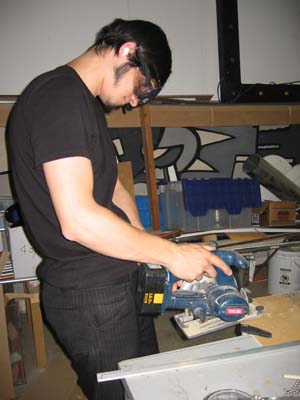
Anika cuts a pouch out of a piece of leather. (Sorry, vegans!)
The wireless device payload will be placed inside the pouch.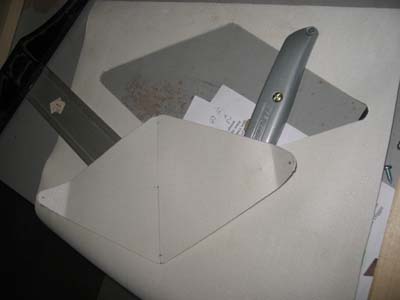
The sling is braided from rope. It has a captive end attached to the arm, and a free end whose loop slips from a hook.
(Very important: knots, a method for fastening or securing linear material such as rope by tying or interweaving.)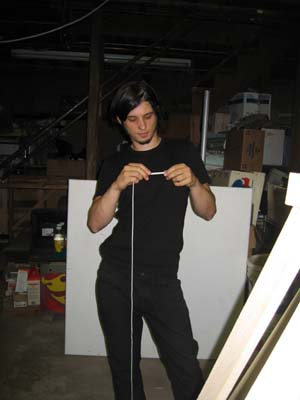
To stabilize the whole construction, Daniel and Anika screw a plexiglas plate to the base.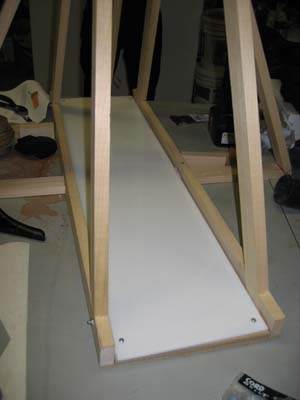
Daniel and Johannes experiment with different weights and finally gage the catapult with a couple of 1 Litre Schweppes Tonic Water bottles.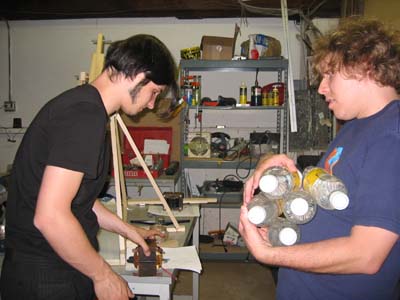
The WIRED block needs a grip.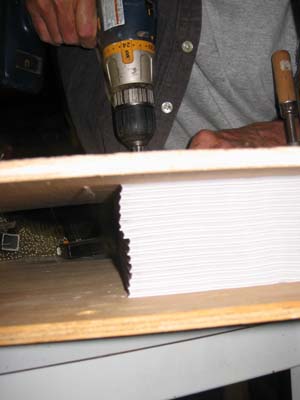
We use WIRE.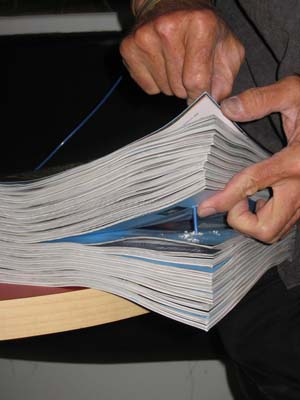
Pouch is finally ready.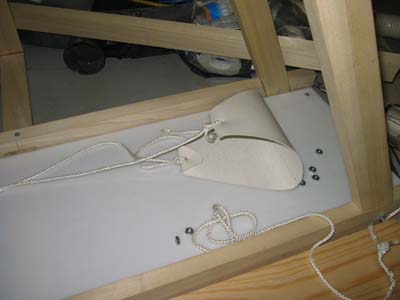
The trigger (or release pin), we use a nail, holds the arm down after the trebuchet is cocked. When the trigger is released, the arm pulls the sling out of a channel in the base of the frame. When the wireless device moves close to the top of its arc, the free end of the sling slips from the hook, and the wireless devices flies free.
(Beware.)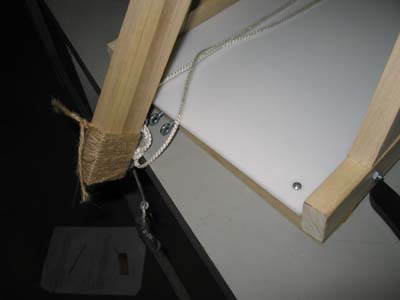
Testing backup counterweight.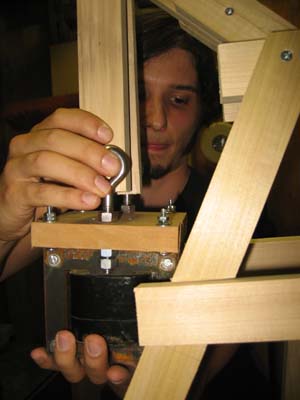
Pride will have a (gadget) fall.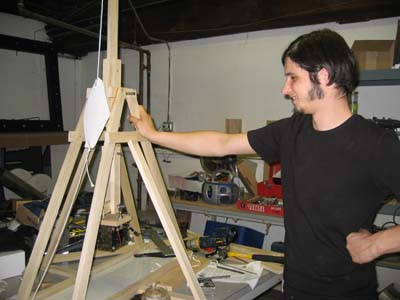
Small adjustments in elevation can be made by changing the angle of the hook holding the free end of the sling. The length of the sling can be altered. The perfect release angle is when the missile will fly at roughly 45 degrees.
To guarantee the stability of the catapult, Anika additionally secures the glued parts with cord.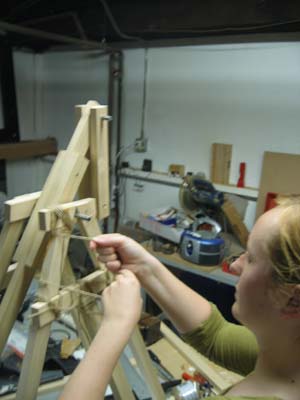
We go to sleep.
Final test. Tomorrow.
[posted by johannes at
10:00 PM]
Counterweight And Ammunition
July 14. Afternoon.
Our catapult needs a counterweight.
We need some issues of WIRED magazine.
Johannes calls WIRED and is being connected to Erica, a friendly member of the staff. He tells her that we want to catapult wireless devices, therefore we urgently need a couple of techno-utopian magazines. Luckily, Erica informs us that we can come to the office tomorrow at 11 AM to talk about our requirements.
July 15. Morning.
WIRED office, 520 3rd Street, 3rd floor, pink door.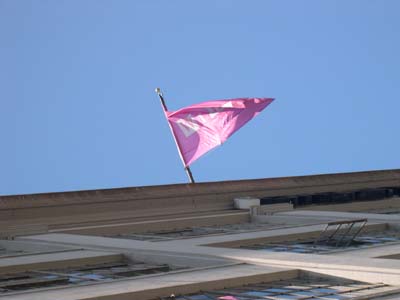
Erica welcomes us and introduces our group to Rebecca.
Rebecca shows us around and talks about the complicated process of creating, laying out and printing the magazine.
The big column in the center of the loft reminds us of the central core of Death Star II. No offense... just architecture.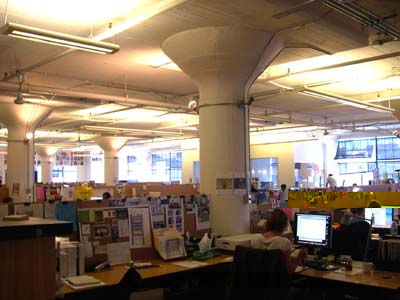
It is really incredible how many people work to create a counterweight.
We wonder if it's possible to simplify that process.
Two friedly guys from the gadget department join us for a group picture.
We are free to take 12 copies of WIRED 07-05.
That's really exciting (so to say somewhere beyond "w00t" and "kewl").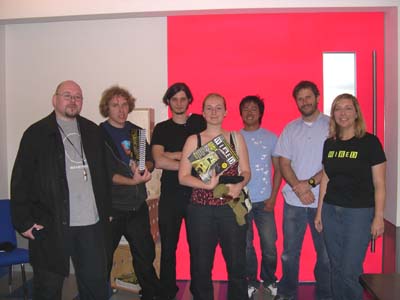
We put the issues in our trunk.
Still, we need some test ammo.
We decide to drive to ACE junkyard, the place Mark Pauline recommended.
On the way we discuss a couple of issues.
- Will 12 copies be enough?
- If yes: What is the dropping distance of the counterweight?
- Assuming that our construction is 100% efficient, what is the maximum height that we can launch the wireless device?
- What is the maximum velocity?
- What is the maximum lateral distance?
- What is the actual maximum height, velocity and lateral distance?
- Why is it different?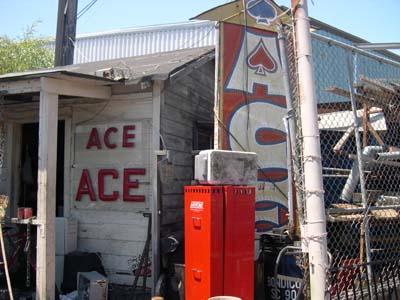
ACE junkyard is pure aesthetics of decay.
Unfortunately the place is as unclear as the real-estate market after the dot com crisis.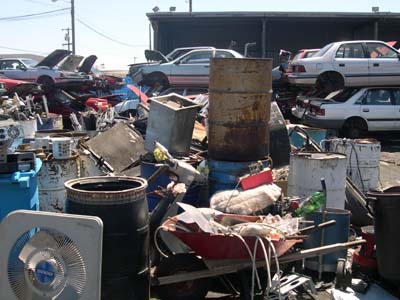
Good to know that there is 'Bill the Junkman'.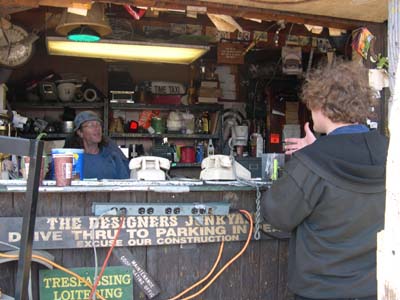
Bill tells us that there are no wireless devices at all...
maybe they are all in Orlando.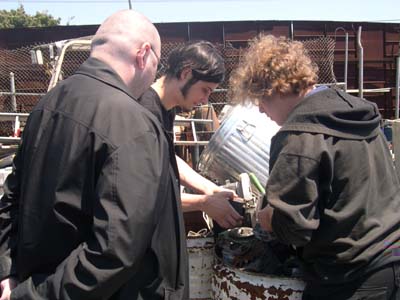
But Bill has a couple of cellphones and PDAs at home.
If we return tomorrow morning he'll provide us with beautiful GSM projectiles... right in time to carry out the final test.
Thanks, Bill!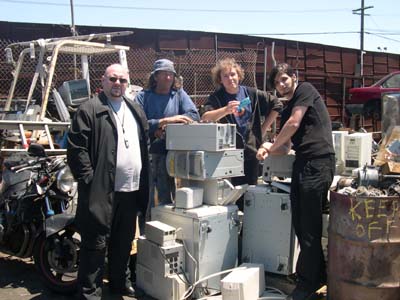
[posted by johannes at
2:23 PM]
Construction, Day 3
July 12. Afternoon.
We think it's Brook's Law that says "the first 90% of the work takes the first 90% of the schedule; the remaining 10% of the work takes the other 90% of the schedule".
Well...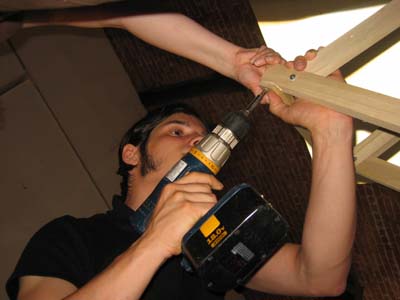
91%.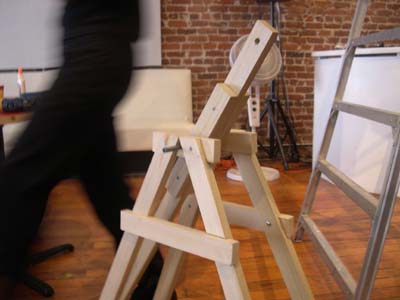
92%.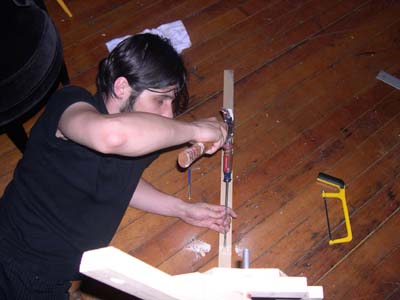
93%.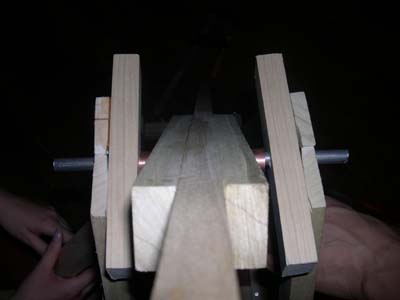
94%.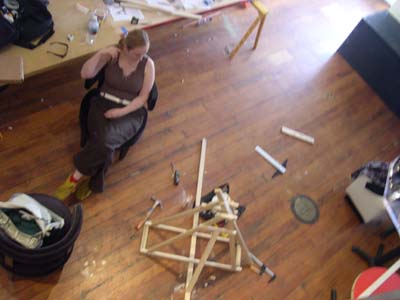
Still 6% left.
[posted by johannes at
5:27 PM]
Construction, Day 2
July 11. Afternoon.
As we don't believe in Intelligent Design we can't wait for some higher power to finish our catapult.
So we continue in our quest...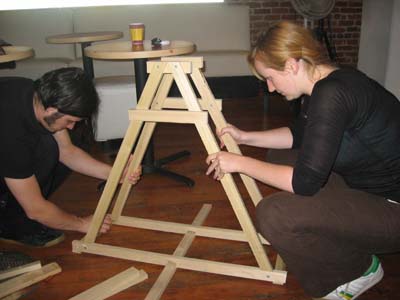
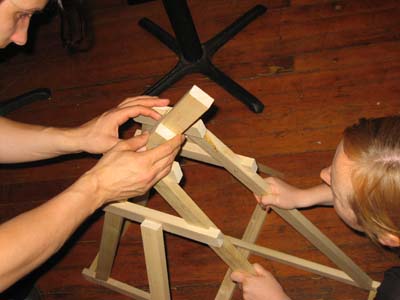
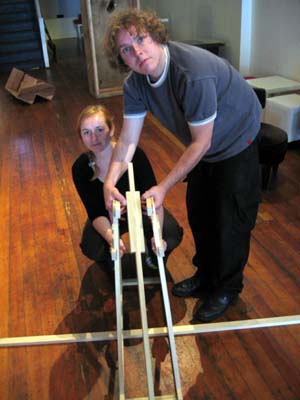
Karen Marcelo points out some possible catapulting locations for the event on Saturday, July 16.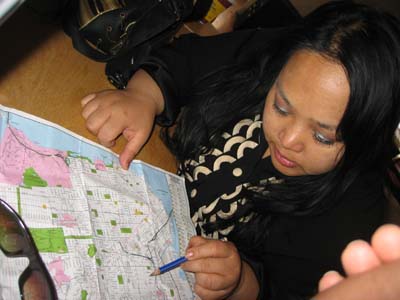
We still need cell phone and PDA ammunition, so we decide to visit Mark, Amy and Jake @ Survival Research Labs.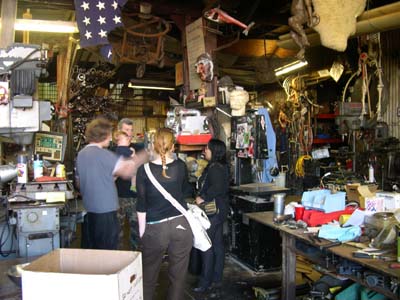
Unfortunately they only have real ammo, but no wireless devices. Luckily, Mark knows a good junkyard where we can find the stuff we need.
[posted by johannes at
3:54 PM]
Buy'n Build
July 9. Afternoon.
We want to catapult wireless devices.
We have a blueprint.
We have Nokia testing ammo.
We have local money.
So...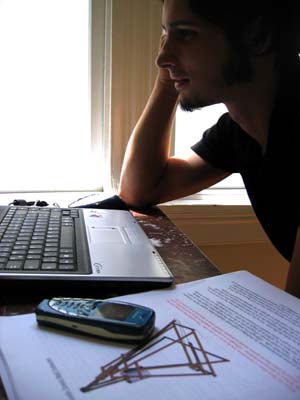
...let's buy stuff.
Daniel, Anika and Will drive to Oakland, CA.
We help the US economy and visit the world's largest home improvement retailer, operating more than 1500 stores across North America.
First, Daniel carefully chooses timber. (Timber, or wood, is an organic material found as the primary content of the stems of woody plants, especially trees, but also shrubs.)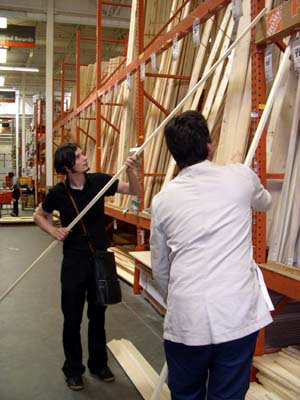
Second, we need screws.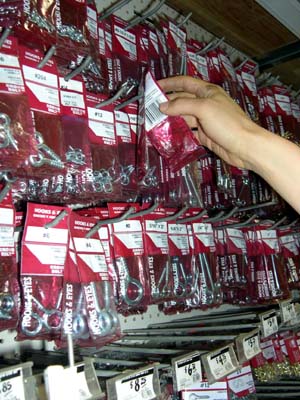
Third, we need an axis.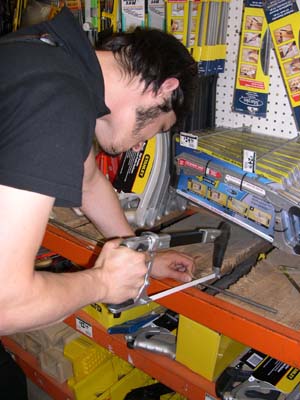
July 9. Evening.
Workshop starts.
Precaution!
Ready, steady...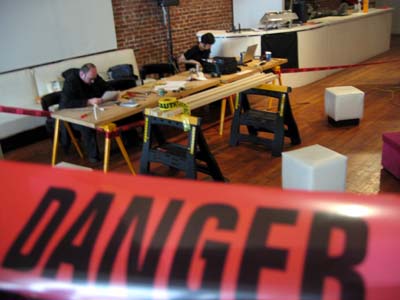
Measuring!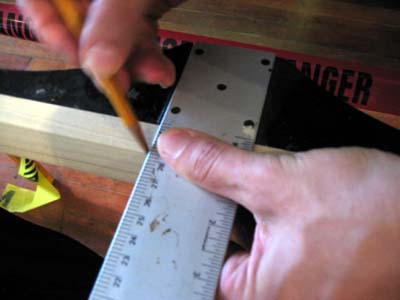
Sawing!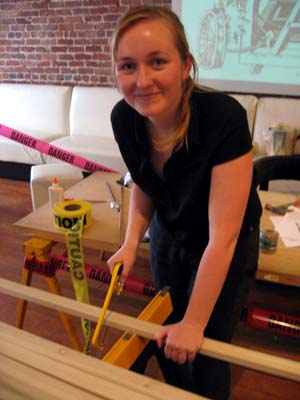
Posing (with throwing arm)!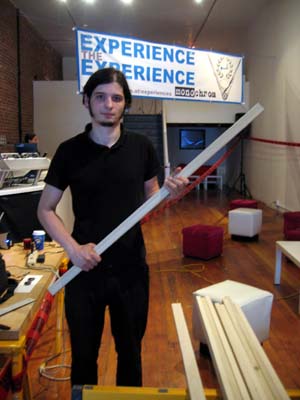
Sorting!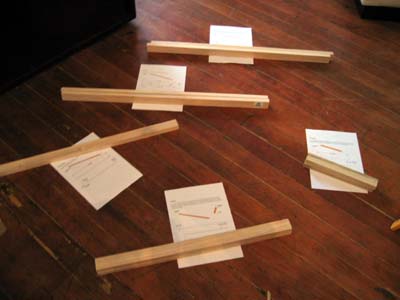
Drilling!
Sniffing!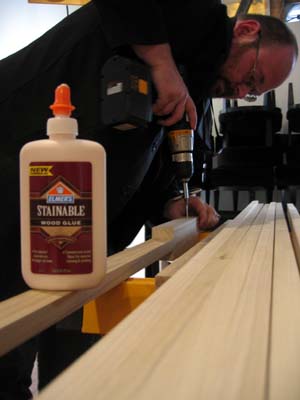
Refining!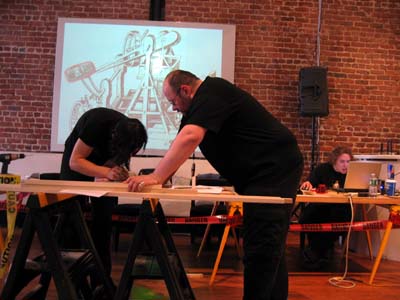
Discussing!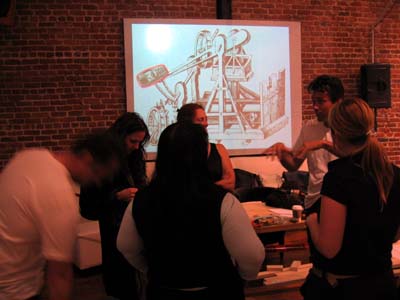
Improving!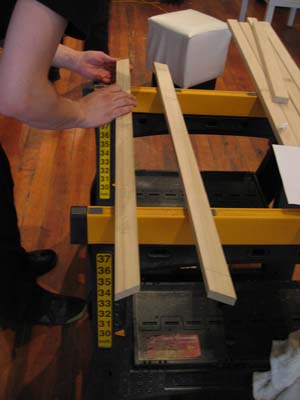
Powerpointing!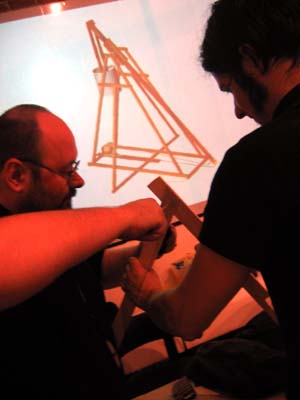
Assembling!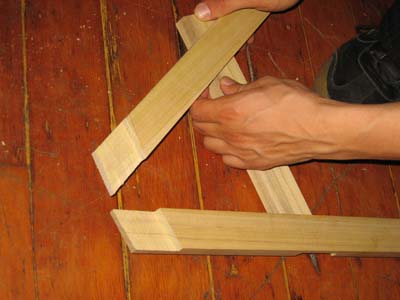
Boasting!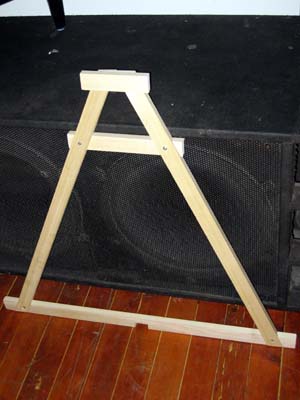
But only the first two segments of the catapult can be finished during the workshop.
Homeworking!
(PS: If you are interested in building a catapult for the competition but couldn't attend the workshop, please feel free to contact Daniel via email.)
[posted by johannes at
10:00 PM]
Experience The Experience Of Catapulting Wireless Devices
[posted by johannes at
2:12 AM]

